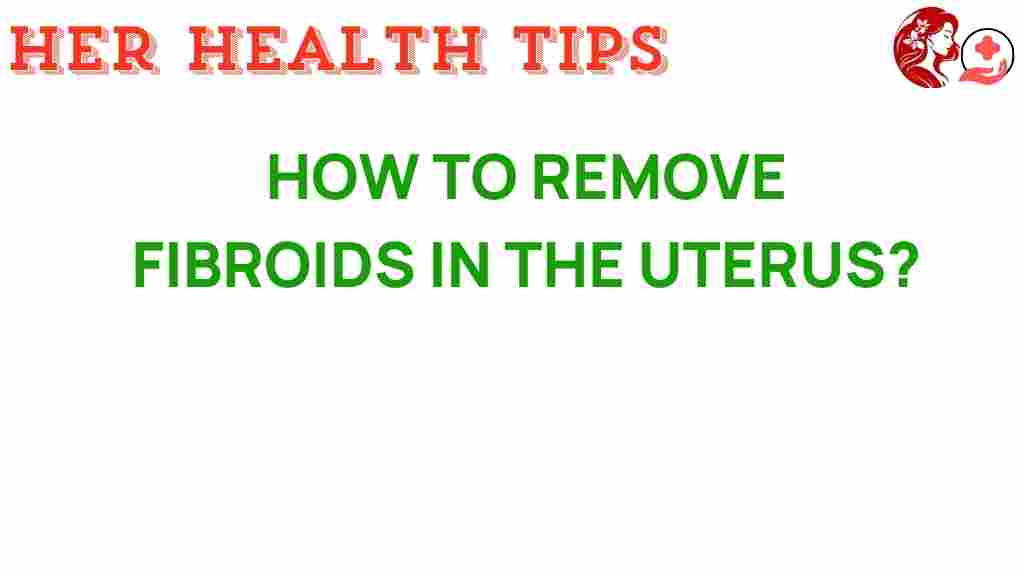Unraveling the Mystery: How to Remove Fibroids in the Uterus?
Fibroids are non-cancerous growths in the uterus that can affect many women’s wellness and uterine health. These benign tumors can vary in size, shape, and location, sometimes leading to troubling symptoms. Understanding how to remove fibroids is essential for those affected, as these growths can interfere with daily life and overall health. This article will explore various treatment options, including surgery, natural remedies, and preventive measures.
Understanding Fibroids and Their Symptoms
Fibroids, also known as uterine leiomyomas, can develop in different areas of the uterus, such as:
- Intramural: These are located within the uterine wall.
- Subserosal: These grow on the outside of the uterus.
- Submucosal: These protrude into the uterine cavity.
Common symptoms of fibroids include:
- Heavy menstrual bleeding
- Pelvic pain or pressure
- Frequent urination
- Constipation
- Back or leg pain
If you experience any of these symptoms, it is crucial to consult a healthcare provider for proper evaluation and diagnosis.
Treatment Options for Fibroids
When it comes to treating fibroids, there are several approaches to consider, depending on the severity of symptoms, the size, and location of the fibroids, and the overall health of the patient. Here are the primary treatment options:
1. Watchful Waiting
For some women, fibroids may not cause significant symptoms. In such cases, a “watchful waiting” approach might be recommended. Regular check-ups can help monitor the fibroids without immediate intervention.
2. Medication
Several medications can help manage symptoms associated with fibroids:
- Hormonal treatments: Birth control pills can regulate menstrual cycles and reduce heavy bleeding.
- GnRH agonists: These medications can shrink fibroids but are usually prescribed for short-term use due to potential side effects.
- Anti-inflammatory drugs: Over-the-counter pain relievers can alleviate discomfort.
3. Natural Remedies
Some women seek natural remedies to manage fibroid symptoms. While these options may not remove fibroids, they can help improve uterine health:
- Dietary changes: Incorporating fruits, vegetables, and whole grains can promote overall wellness.
- Herbal supplements: Some herbs are believed to support uterine health. Always consult a healthcare provider before starting any supplements.
- Stress management: Practices like yoga and meditation can help reduce stress, which may indirectly impact fibroid growth.
4. Surgical Options
If fibroids cause severe symptoms or complications, surgical interventions may be necessary. Here are common surgical options:
- Myomectomy: This procedure involves the surgical removal of fibroids while preserving the uterus. It can be performed through various methods, including laparoscopic surgery.
- Hysterectomy: In severe cases, a hysterectomy, or removal of the uterus, may be recommended. This option is typically considered for women who no longer wish to conceive.
- Uterine artery embolization (UAE): This minimally invasive procedure cuts off the blood supply to the fibroids, causing them to shrink.
Recovery After Fibroid Removal Surgery
Recovery from fibroid removal surgery varies based on the type of surgery performed. Here are some general recovery tips:
- Follow post-operative care instructions: Adhere to the guidelines provided by your surgeon to ensure proper healing.
- Rest: Allow your body ample time to recover; avoid strenuous activities for a specified period.
- Manage pain: Use prescribed pain medications as needed and communicate any concerns with your healthcare provider.
- Attend follow-up appointments: Regular check-ups are vital to monitor healing and address any complications.
Preventing Fibroids: Lifestyle Changes
While there is no guaranteed way to prevent fibroids, certain lifestyle changes can promote women’s wellness and potentially reduce the risk:
- Maintain a healthy weight: Obesity is linked to an increased risk of fibroids.
- Regular exercise: Physical activity can help regulate hormones and maintain a healthy weight.
- A balanced diet: Consuming a diet rich in fruits, vegetables, and lean proteins can support overall health.
- Avoiding processed foods: Reducing intake of processed and high-fat foods may also benefit uterine health.
When to Seek Help
It is essential to consult a healthcare provider if you experience symptoms of fibroids or if you notice any changes in your menstrual cycle. Early detection and intervention can help manage symptoms and improve quality of life.
Troubleshooting Common Concerns
Here are some common concerns related to fibroids and their treatment:
1. Will fibroids come back after treatment?
Fibroids can recur even after treatment. Regular monitoring and lifestyle changes may help manage their growth.
2. Can I still have children after fibroid treatment?
Many women can conceive after fibroid treatment, especially if a myomectomy is performed. However, it is crucial to discuss your specific situation with your healthcare provider.
3. Are there any complications associated with fibroid surgery?
As with any surgery, there may be risks involved. Discuss these risks with your surgeon before proceeding with treatment.
Conclusion
Removing fibroids in the uterus can significantly enhance women’s wellness and uterine health. With various treatment options available, ranging from natural remedies to surgical procedures, it is vital to consult healthcare professionals to determine the best course of action based on individual needs. Maintaining a healthy lifestyle with proper diet and exercise can also play a crucial role in prevention and management. For further information on women’s health and wellness, consider exploring resources such as the American College of Obstetricians and Gynecologists.
Remember, understanding your body and seeking prompt medical advice can lead to better outcomes and improved quality of life.
This article is in the category Reproductive and created by HerHealthTips Team
